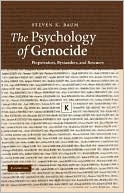

 |

|

The average rating for Psychology of Genocide: Perpetrators, Bystanders, and Rescuers based on 2 reviews is 4 stars.
Review # 1 was written on 2018-08-20 00:00:00 Carl Michaelis Carl MichaelisAnalyzing Evil A useful lens for examining the kind of personality who would be attracted to genocidal movements and a reasonable starting point for other material such as the Milgram experiments, research on Nazi attitudes towards their "work", the ideology of terrorism and contemporary massacres such as the Rwandan genocide, supplemented with a good number of illustrative examples. 'I got into it, no problem, " says one gang member. "Killing is easier than farming", reported another. Each describes what it was like the first time he killed someone, what he felt like when he killed a mother and child, how he reacted when he killed a cordial acquaintance, how cutting a person with a machete differed from cutting a calf or a sugarcane. Some offenders claim that we changed into wild animals, that we were blinded by ferocity... that is a trick to sidetrack the truth. I can say that outside the marshes our lives seemed quite ordinary. .... We swapped gossip at the cabaret, we made bets on our victim, spoke mockingly of cut girls, squabbled foolishly over looted grain. We sharpened our tools on whetting stones. We traded stories about desperate Tutsi tricks, we made fun of every "Mercy!" cried by someone who'd been hunted down, we counted up and stashed away our goods.' pp123 As poet Leonard Cohen once wrote about Adolph Eichman - "What did you expect, fangs?" One useful analysis is Adorno's F (fascism) scale (pp118) which lists subservience to authority, preoccupation with power, extreme cynicism towards motives,and exaggerated preoccupation with the morals of others and projection of their own aggressiveness as some of the characteristics of those who are inclined to obey authority and act aggressively towards others. However Adorno identifies these tendencies solely as a phenomenon of the far right. Many genocideers and their enablers cite a belief in working for public good. Dr Anat Barko who has studied dozens of would be suicide bombers (pp82) found that suicide bombers had become role models for Palestinian youth. In one study 36% of 12 year old boys and 17% of Palestinian girls cited personal goals of wanting to die as a shaheed. Similarly, in the 1969 anti Muslim riot in Ahmedabad, India, the violence was deemed "very necessary" and in Nigeria in 2002 where 200 people were killed and 500 injured over because Muslim "sensibilities" were offended by the holding of the Miss World contest in that country. The madness of crowds indeed! What should concern us is the potential of any society, including our own, to slide into a way of thinking where this there this kind of behaviour is considered "normal", especially in tough times where there is a temptation to create scapegoats for society's problems. Baum cites historian Christopher Browning who estimates that only 5% of SS members were actually sadists and that between 10-20% of Nazi soldiers evaded killing Jews (pp183) - and in the German police the number refusing to kill rose to 20-30% - which still leaves 70-80% who were, to a differing degree, willingly complicit. This includes 42% who "were just following orders" and only 21% who complied out of fear. Nor is education or intelligence a guarantee - of 56 leading Nazis, Browning says, more than 50% were MDs and lawyers. In the population as a whole (pp105), grouping by personality traits deemed belonging to perpetrators, bystanders and rescuers form a bell curve, with the middle group (bystanders) forming a majority of 60-70%, and roughly equal numbers of the other two groups at the far ends. The derivation of this curve seems supported by the Milgram experiments, and I believe it to be reasonable, but Baum could have provided more explicit support. The book Extraordinary Evil: A Short Walk to Genocide by Barbara Colorosso, which came out around the same time, introduces a more refined breakdown via Dr. Dan Olweus' "Bullying Circle". Instead of just perpetrators, bystanders and rescuers, Olweus has a spectrum of 8 categories: Bullies who instigate and plan, Henchmen who assist, Active Supporters who cheer the bully on, Passive Supporters who do nothing but provide a buffer against preventative action, Disengaged Onlookers, Potential Witnesses who oppose the bullying but do not act, Active Resisters who do act and finally the Victims themselves. Colorosso's book is complementary, but is not as academic. It's a good book but IMV it passes on equally dangerous behaviour coming from the left, for example citing Christopher Hedges' views on the elements of the Christian right (pp128) - in itself a potentially valid criticism, but ignoring Hedge's far left attacks on liberalism and democratic institutions, regarding them as irredeemably "corrupt". Recommended. |
Review # 2 was written on 2012-04-06 00:00:00 Kamal Hasan Kamal HasanBasically a clinical perspective on genocide, there are some very good examples and stories to support Baum's theory and I really enjoyed reading those. There is some wrong information regarding wrong names etc. (Gregory H. Stanton is the author of 8 "The 8 Stages of Genocide" according to , not "Glenn Stannard" as Baum wrote; Yad Vashem is not "the Israeli organization that honors those who risked their lives for saving Jews", it's more like an international holocaust memorial center and the Israeli government is doing the honoring part...) |
CAN'T FIND WHAT YOU'RE LOOKING FOR? CLICK HERE!!!